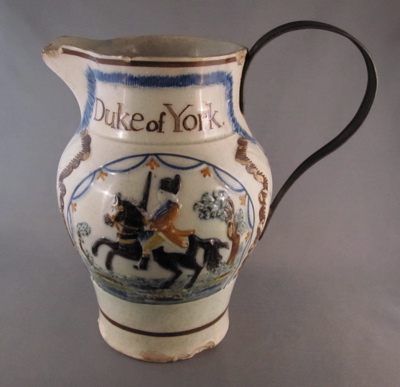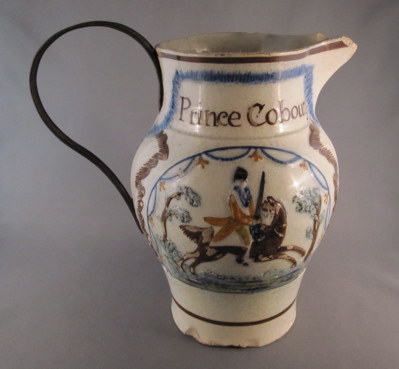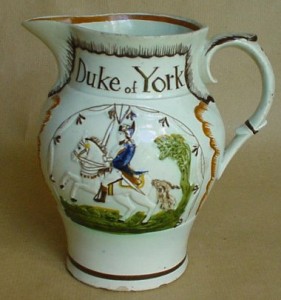Posts Tagged ‘metal handle’
Friday, March 19th, 2010
A charming English pottery jug from Staffordshire measures 6-1/2″ high, with colorful relief images of children and dates from the early 1800’s. One side shows a boy, a girl holding a doll and their dog and is marked “Sportive Innocence”.
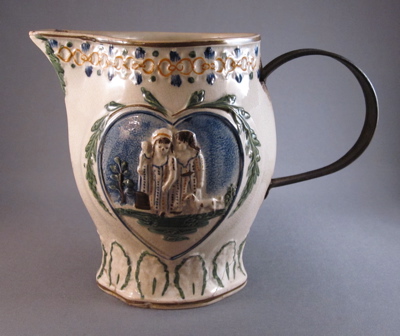
The other side shows the girl and boy fighting and is marked “Mischievous Sport”.
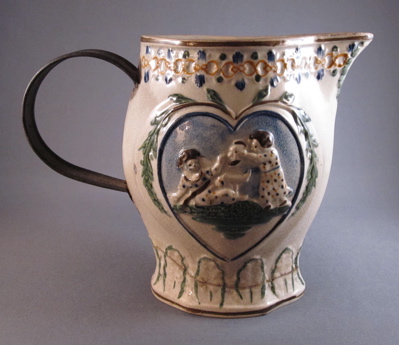
A metal handle was firmly put in place when the original handle broke off, most likely by mischievous children!
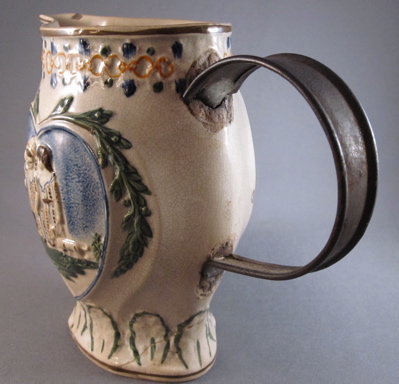
This jug is shows what the original molded handle looked like.
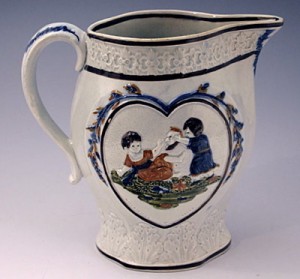
Photo courtesy of John Howard
Tags:English, metal handle, pottery, prattware, Staffordshire
Posted in jug | No Comments »
Thursday, March 18th, 2010
This large Chinese porcelain mug from the Qianlong (pronounced SHEEN-LOONG) period is from the mid-1700’s and is decorated in the Mandarin style with polychrome enamels.
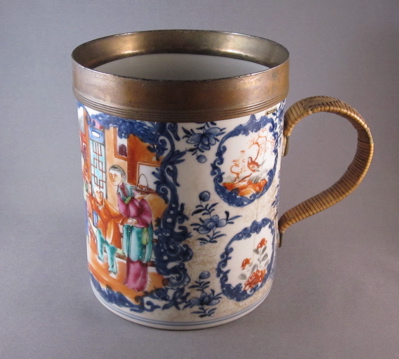
Mug measures 5-3/4″ high and has a finely painted courtyard scene, wrapping around three sides.

I love when there are multiple repairs on one object and this mug boasts three different types of inventive repair, including an incised bronze collar to mask chips along the rim.
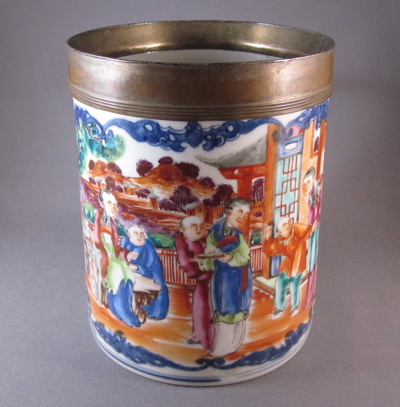
A wicker wrapped bronze replacement handle stands in for the long lost original porcelain handle. Just below the brass collar are metal staples which stabilize a vertical crack.
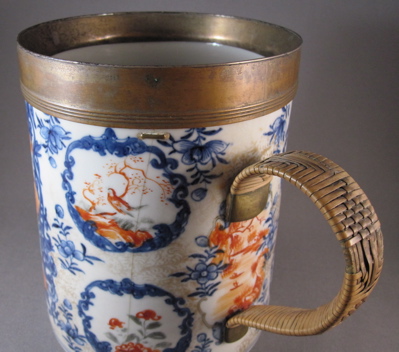
The original handle was simply shaped, much like the one pictured below.
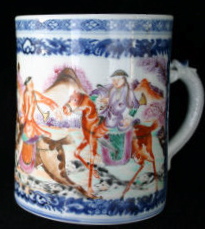
Photo courtesy of Guest & Gray
Tags:bronze, Chinese, Mandarin, metal handle, Qianlong, rattan, staples/rivets
Posted in mug/tankard | No Comments »
Thursday, March 18th, 2010
This German porcelain teacup with scalloped rim is delicately painted with a Watteau style figures in a landscape and floral sprigs in tones of copper green, pink and black. It dates from the middle 1700s and bears a cobalt blue crossed swords mark on the underside. It measures 2-3/4″ tall.
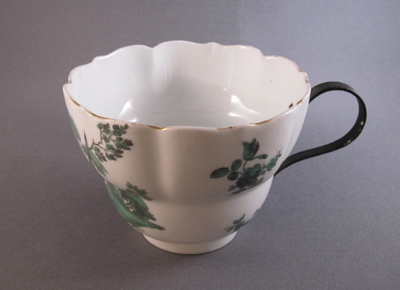
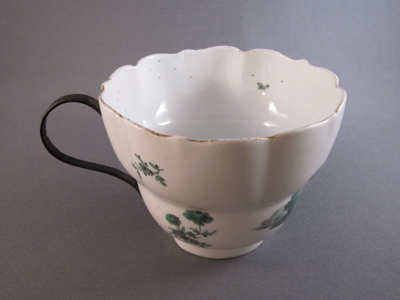
A tiny leaf is painted on the inside of the cup, masking one of the few pinpoint sized bubbles in the glaze.

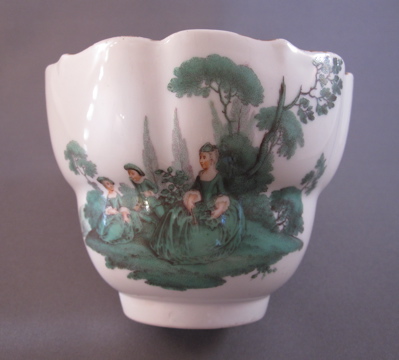
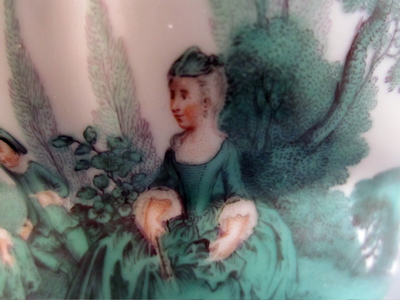

The underside reveals a cobalt blue crossed swords mark.
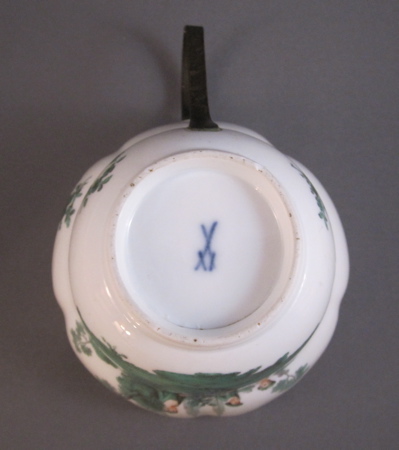
A well made forged bronze replacement handle from mid-1800s takes the place of the more fragile porcelain original, which must have snapped off early in the cup’s life.
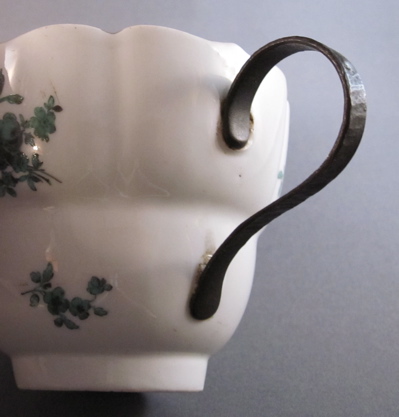
The hand hammered bronze pins are seen from the inside of the cup.

This is what the original “split twig” handle might have looked like.
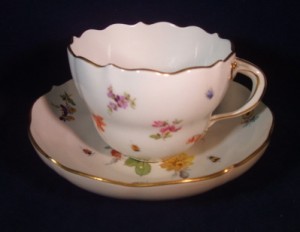
Photo courtesy of Cyberattic
Tags:bronze, German, Meissen, metal handle
Posted in cup/saucer | 1 Comment »
Wednesday, March 17th, 2010
I was thrilled when I stumbled upon this late 1800’s stoneware “bean pot type pitcher” as described to me by a Maine antiques dealer. The only problem is that after I purchased it, I discovered it had never been repaired, thus not a make-do.
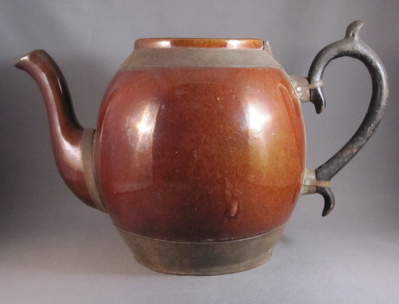
The handle and straps are original to the pot and I was fooled! I am sure that the dealer thought it was authentic and did not mean to deceive me. Rather than return the piece, I am keeping it as cautionary reminder to thoroughly examine each piece before purchasing

What I ultimately found stamped on the lower band: “PAT. JUNE 27 1876, M. SCHIFFER, ST LOUIS MO”
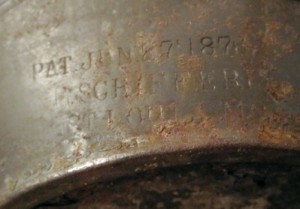
Tags:American, metal handle, stoneware
Posted in teapot | 4 Comments »
Wednesday, March 17th, 2010
A Chinese porcelain globular form teapot with Japanese influenced Imari decoration, stands 4″ high. The bullet shape was inspired by European silver of the same period.

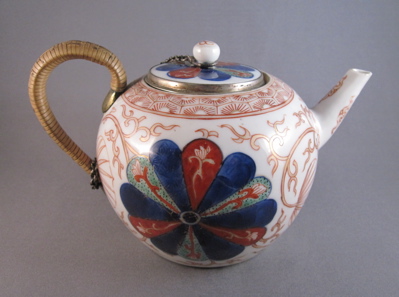
When the original porcelain handle broke off, the teapot was taken to a china mender and fitted with a bronze handle replacement. Finely woven rattan embellishes the metal handle as well as provides protection from the heat of a pot full of hot tea.
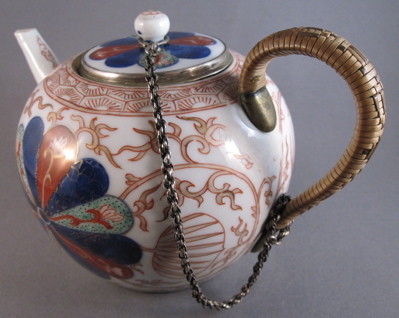
A silver rim was added to mask chips along the lid and a silver “safety” chain keeps the lid and the teapot together.
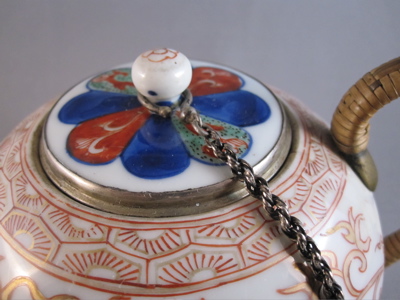
This teapot with similar form and decoration still sports its original handle.
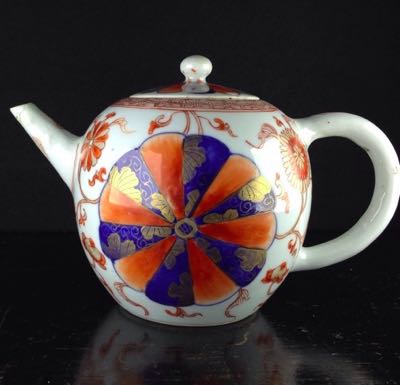
Photo courtesy of Moorabool Antiques
Tags:bronze, Chinese, globular, Imari, metal handle, rattan, silver
Posted in teapot | 2 Comments »
Tuesday, March 16th, 2010
I love miniatures and was really excited to find this tiny two-toned floral sprigged pottery jug, made in Derbyshire, England in the mid-1800’s.
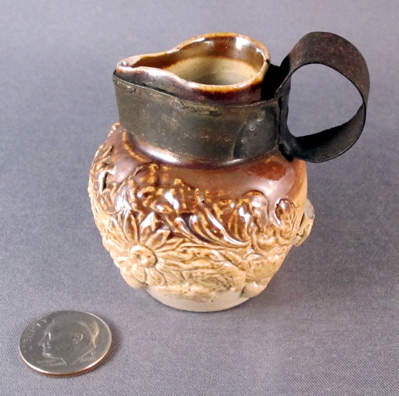
This little jug stands a mere 2″ tall and is made of stoneware with a salt glazed finish, which was fired at a high temperature to insure a glass-like, non-porous surface.

The original handle was replaced with an over scaled tin handle & strap, looking a bit out of proportion on this small jug.
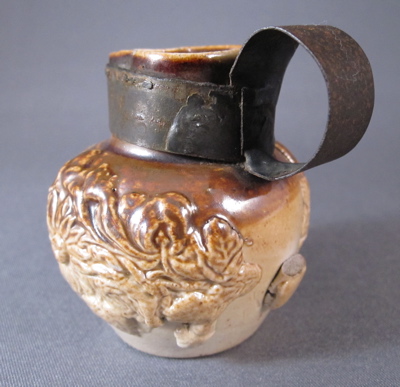
This is what the original jug handle might have looked like had it not broken off.
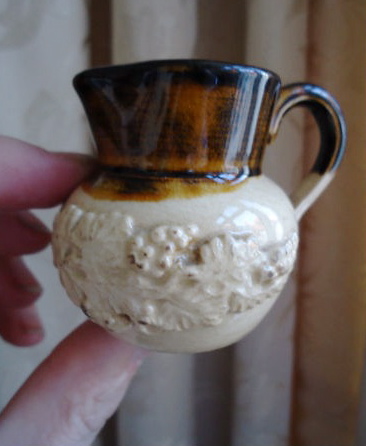
Photo courtesy of eBay
Tags:English, metal handle, miniature, salt glaze, stoneware
Posted in jug | No Comments »
Tuesday, March 16th, 2010
A large jasperware water jug with sprigged decoration, made by potter Richard Dudson in Stoke-on-Trent, England in the mid-nineteenth century. Jug stands 7-3/4″ tall.
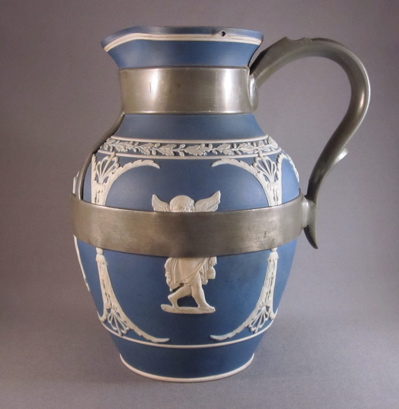
Dudson ceramics pieces are often mistaken for the work of rival potter Josiah Wedgwood, which are similar in form, decoration and color.
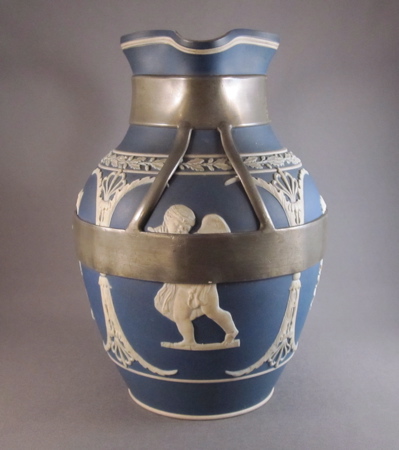
The broken handle was replaced over one hundred years ago by a massive pewter handle & support straps, masking much of the sprigged cherubs decoration.
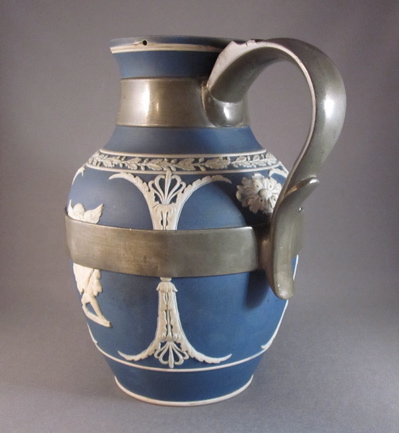
This jug with similar form and decoration shows what the original handle on my jug would have looked like.
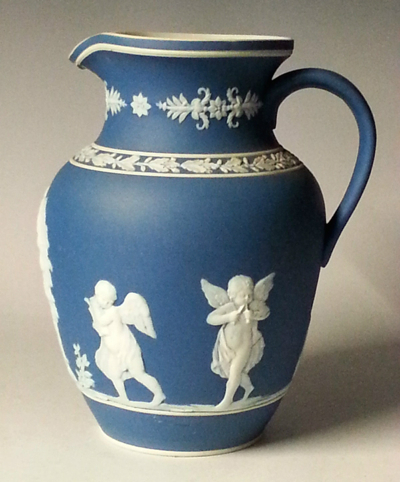
Photo courtesy of eBay
Tags:English, jasperware, metal handle, pewter, Wedgwood
Posted in jug | No Comments »
Monday, March 15th, 2010
A unusual Chinese porcelain baluster form cruet jug with beak spout, stands 5-1/2″ high. It is decorated in the Chinese Imari pattern, using cobalt blue and iron red enamel washes and gilt highlights.
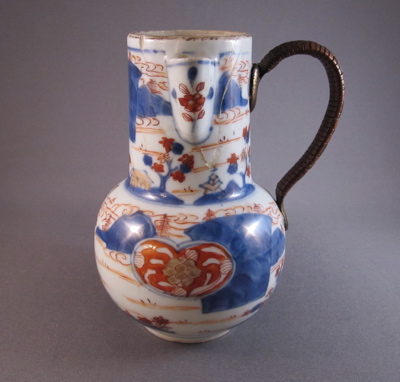
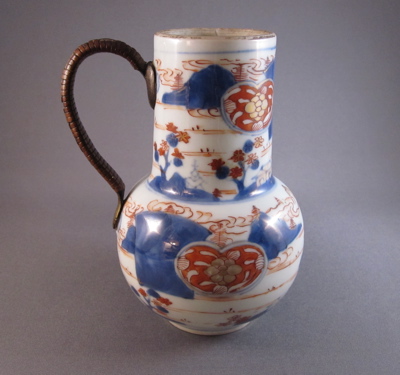
The original porcelain handle has been replaced by a woven rattan covered gilt bronze handle, set at right angle.
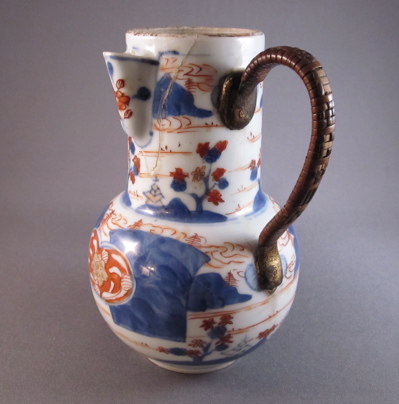

These three examples of similarly formed cruet jugs each have their original handles & lids.
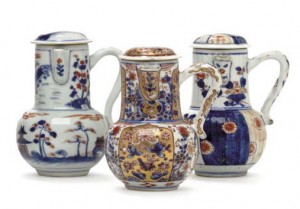
Photo courtesy of Christie’s
Tags:bronze, Chinese, Imari, metal handle, porcelain, rattan
Posted in jug | No Comments »
Monday, March 15th, 2010
American brown glazed stoneware bean pot with lid, measures 5-1/2″ high and is 8-1/2″ wide from handle to handle.
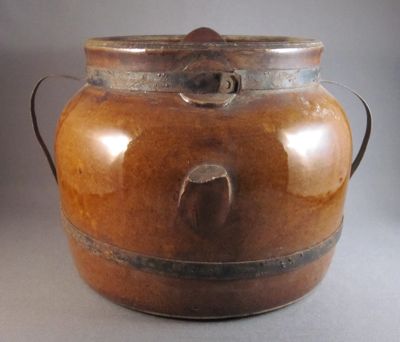
A mismatched lid from another piece has been “married” to this pot.
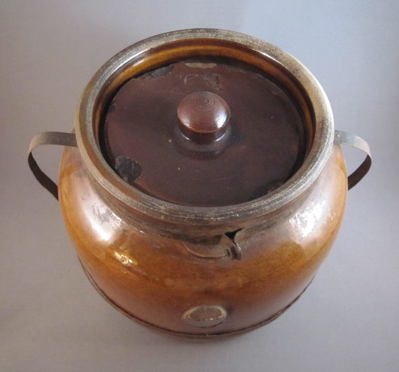
The lid has an incised number “2” on the top right edge.
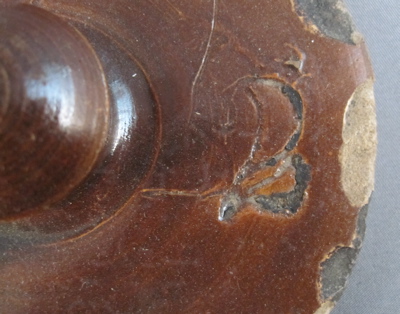
This was most likely made in Ohio or Pennsylvania in the late 1800’s.
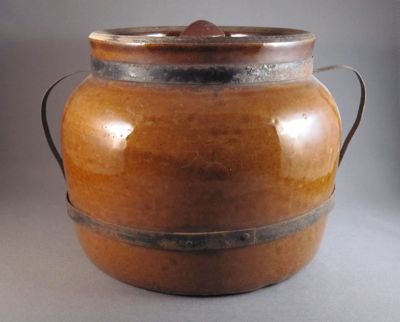
When the single applied stoneware handle broke off, twin metal handles and straps were attached to “improve” upon the original design. The small, lightweight handles are out scale with the heavy pot and have become misshapen from use.
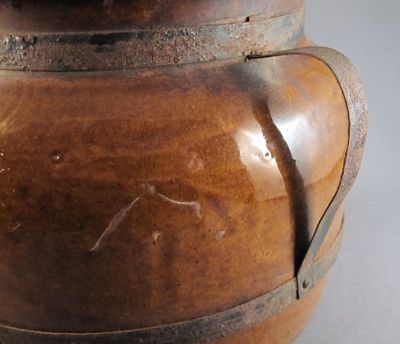
A metal support strap around the top has a bolt and nut to insure a tight fit.
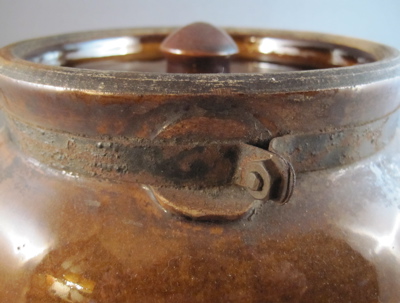
This pot still has its original single handle.

Photo courtesy of Cyber Attic
Tags:American, metal handle, pottery, stoneware
Posted in crock | No Comments »



































